Pollution Absorbing Bricks Market Research: 2032
The Global Pollution Absorbing Bricks Market was valued at $5.3 billion in 2022, and is projected to reach $9.7 billion by 2032, growing at a CAGR of 6.1% from 2023 to 2032. Pollution absorbing brick is a sustainable construction material that helps in reduction of air pollution. In addition, such bricks work on the principle of air filtration. These bricks clean the air outside before supplying it to the interior of the building. They clean the air by removing dust and other impurities, making it safe to inhale. Furthermore, such brick are made up of a special additive or coating such as photocatalytic coatings and surface coatings that enable them to absorb and neutralize harmful pollutants present in the air.
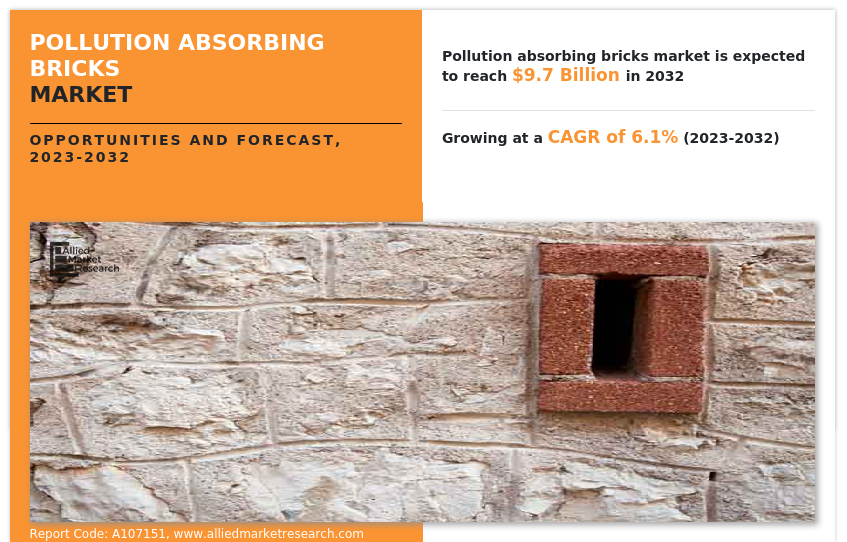
Market Dynamics
Rise in awareness regarding use of sustainable and environmentally friendly construction material and their impact on the environment acts as the key driving force of the global pollution absorbing bricks industry.
In addition, pollution absorption bricks offer an advanced solution for reducing pollution by filtering hazardous substances from the air, water, or soil. This reduces pollutant levels and improves the standard of living. Moreover, pollution, especially air pollution, has an adverse impact on human health. Furthermore, pollution absorption bricks improve the air quality and reduce the risk of respiratory illnesses, allergies, sickness, and other health issues by reducing the number of pollutants in the surrounding environment. Therefore, such benefits fuel the growth of the market which is further helping in expansion of pollution absorbing bricks market size.
However, lack of awareness regarding multiple benefits associated with pollution absorbing bricks among numerous customers, developers, or builders restrains the market growth. In addition, low demand for certain materials because of lack of knowledge regarding such advanced technology materials lowers the level of acceptance. To ensure that stakeholders are aware of the benefits of pollutant absorption bricks and their possible effects on the environment and human health, education and awareness efforts are essential. Moreover, manufacturing of pollution absorbing bricks is more expensive than producing conventional building materials. Investment is limiting its adoption for all types of construction. Hence, such lack of awareness and education and higher upfront costs restrain the pollution absorbing bricks market growth.
Segmental Overview
The global pollution absorption bricks market is segmented into material type, application, end user, and region. On the basis of material type, the market is bifurcated into concrete and clay. By application, it is classified into structural and nonstructural. Depending on end user, it is divided into residential and nonresidential. Region wise, it is analyzed across North America (the U.S., Canada, and Mexico), Europe (UK, Germany, France, Spain, Italy, Netherlands, and rest of Europe). Asia-Pacific (China, Japan, India, South Korea, and rest of Asia-Pacific), and LAMEA (Latin America, the Middle East, and Africa).
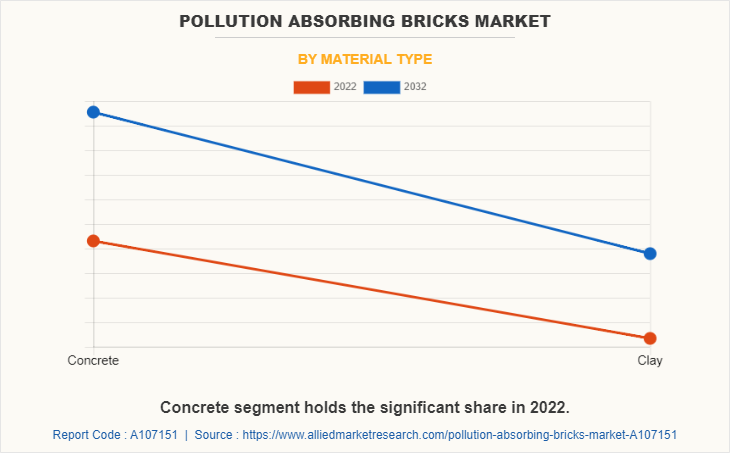
By Material Type:
Based on material type, the concrete segment generated the highest revenue in 2022, while clay segment is expected to grow with the highest CAGR during the forecast period. Concrete pollution- absorbing bricks serve as an efficient solution to lower air pollution in urban areas, thus increasing their demand. In addition, the demand for concrete pollution- absorbing bricks is driven by a combination of environmental awareness, rise in concerns about urban air quality. In addition, Clay pollution- absorbing bricks, with their ability to reduce air pollution, often aligns with these regulations, leading to a growing demand for their use. These bricks offer a viable solution to reduce air pollution while maintaining the natural and aesthetic qualities of construction.
On the contrary, the construction industry is growing at a notable pace due to rapid urbanization and industrialization of developing nations. The market growth is majorly driven by increase in demand for infrastructure and building projects. The necessity for building new infrastructure is being driven by the ongoing development of the residential and nonresidential construction sectors. For insulation and pollution reduction, concrete and clay pollution absorbing bricks are in high demand in the building sector, as they are eco-friendly and less harmful.
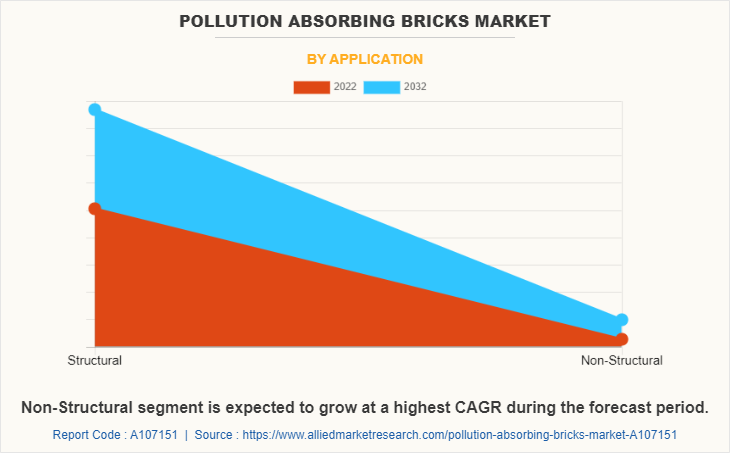
By Application:
Based on application it segmented into structural and non-structural. The structural segment generated the highest revenue in 2022. However, the nonstructural segment is expected to grow with the highest CAGR during the forecast period. Raising awareness regarding the negative impacts of air pollution on the environment and human health. Thus, this creates demand for sustainable solutions that reduce the harmful effect of air pollution and improve air quality. In addition, in nonstructural, there is growing concern regarding the air quality as a result of rising urbanization and pollution levels in certain regions. Allergies and respiratory issues are just among the health risks of poor air quality that are becoming more generally recognized.
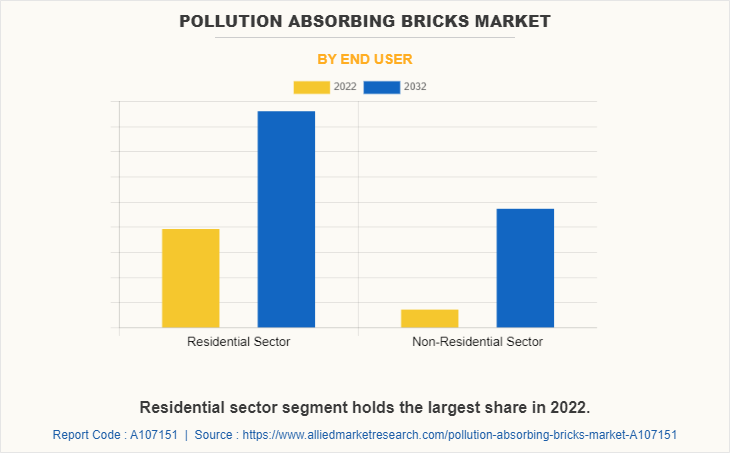
By End User:
Based on end user, it is segmented into residential sector and nonresidential sector. The residential sector segment generated the highest revenue in 2022. However, the nonresidential sector segment is expected to grow with the highest CAGR during the forecast period. The demand for pollution absorbing bricks in residential applications is rising significantly as the migration toward cities is increasing to lessen the negative impacts of air pollution and for healthier living conditions. In addition, the use of pollution absorbing bricks in the non-residential sector aims to reduce air pollution, create healthier environments, and prioritize the well-being of occupants, visitors, and workers.
Pollution absorption bricks are used for the construction of residential buildings in various ways to improve air quality and create a healthier living environment. In addition, Pollution absorption bricks used for the construction of non-residential buildings such as commercial and industrial buildings.
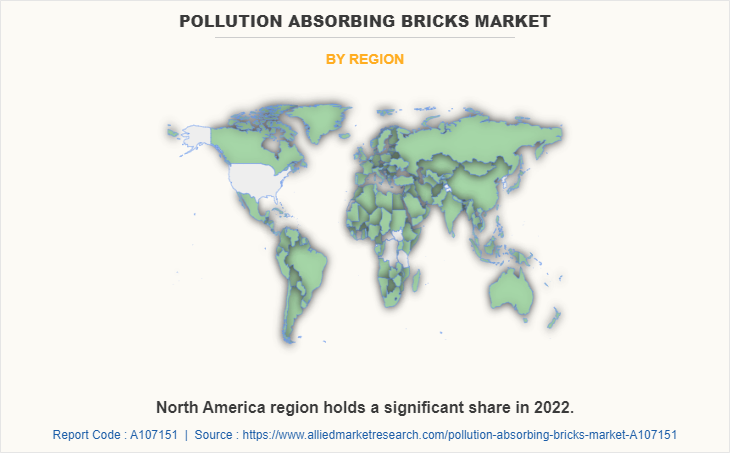
By Region:
The pollution absorbing bricks market is analyzed across North America, Europe, Asia-Pacific, and LAMEA. In 2022, North America held the highest revenue in pollution absorbing bricks market share. Rapid urbanization and infrastructure development projects in North America such as (U.S., Mexico and Canada) are driving the demand for construction materials. Furthermore, according to U.S. census data published in 2021, U.S. is the leading construction and manufacturing market, accounting for around $1.589 trillion, registering 4.3% of the total GDP of the country. Thus, increase in sustainable construction activities requires pollution absorbing bricks to minimize the pollution and creating sustainable growth opportunities for the market in this region. However, LAMEA is expected to exhibit the highest CAGR during the forecast period. LAMEA majorly includes developing countries; therefore, there is a vast scope for urbanization and industrialization in this region. In addition, new residential and nonresidential construction activities are ongoing in these countries, which is expected to boost the demand for pollution absorbing bricks.
Competition Analysis
The major players profiled in the pollution absorbing bricks market include Wienerberger, Ramtsilo Bricks & Construction, Ecobrick Alliance Earth Enterprise, Acme Brick Company, Midwest Block & brick, Triangle Brick Co., Brampton Brick, General Shale Inc., Glen-Gery Corporation, and Carolina Ceramics Brick Company.
Major companies in the market have adopted acquisition, product launch, business expansion, and other strategies as their key developmental strategies to offer better products and services to customers in the pollution absorbing bricks market.
Key Benefits For Stakeholders
- This report provides a quantitative analysis of the pollution absorbing bricks market forecast along with market segments, current trends, estimations, and dynamics of the pollution absorbing bricks market analysis from 2022 to 2032 to identify the prevailing pollution absorbing bricks market opportunities.
- The market research is offered along with information related to key drivers, restraints, and opportunities.
- Porter's five forces analysis highlights the potency of buyers and suppliers to enable stakeholders make profit-oriented business decisions and strengthen their supplier-buyer network.
- In-depth analysis of the pollution absorbing bricks market segmentation assists to determine the prevailing market opportunities.
- Major countries in each region are mapped according to their revenue contribution to the global market.
- Market player positioning facilitates benchmarking and provides a clear understanding of the present position of the market players.
- The report includes the analysis of the regional as well as global pollution absorbing bricks market trends, key players, market segments, application areas, and market growth strategies.
Pollution Absorbing Bricks Market Report Highlights
| Aspects | Details |
| Market Size By 2032 | USD 9.7 billion |
| Growth Rate | CAGR of 6.1% |
| Forecast period | 2022 - 2032 |
| Report Pages | 212 |
| By End User |
|
| By Application |
|
| By Material Type |
|
| By Region |
|
| Key Market Players | Ecobrick Alliance Earth Enterprise, Carolina Ceramics Brick Company, Ramtsilo Bricks & Construction, Midwest Block & brick, Triangle Brick Co., Acme Brick Company, Brampton Brick, Wienerberger, glen-gery corporation, GENERAL SHALE, INC. |
Analyst Review
Pollution absorbing brick, also known as air purifying brick or smog absorbing brick, is gaining high traction in the construction sector as it helps to curb air pollution. It serves as an innovative solution that combines the functionality of traditional bricks with air purification capabilities. Thus, these are witnessing high demand in construction projects as building facades, pavement, or noise barrier.
Increased concern regarding environmental degradation and pollution has led to the adoption of sustainable and eco-friendly products. Thus, the demand for pollution absorbing bricks is growing significantly to provide a viable treatment for pollution reduction. In addition, the demand for these bricks is influenced by the emphasis on developing healthier living and working environments.
However, while government regulations and incentives drive the adoption of pollution absorption bricks, regulatory challenges reduce their implementation. In addition, inconsistent or ambiguous regulations, lack of standardized guidelines, or conflicting requirements may create uncertainty and slow down the adoption process. Clear and supportive regulations are necessary to facilitate the integration of pollution absorption bricks into construction practices.
On the contrary, the impacts of pollution, particularly air pollution, on human health are quite adverse. By lowering the number of pollutants in the area, pollution absorption bricks can improve the air quality and possibly lower the risk of respiratory conditions, allergies, and other health difficulties. The demand for these bricks may be influenced by the emphasis on developing healthier living and working environments. Hence, such advantages of pollution absorbing brick propel the growth of market.
The global pollution absorbing bricks market was valued at $5,317.0 million in 2022, and is projected to reach $9,666.3 million by 2032, registering a CAGR of 6.1% from 2023 to 2032.
The forecast period considered for the global pollution absorbing brick market is 2022 to 2032, wherein, 2022 is the base year, 2023 is the estimated year, and 2032 is the forecast year.
The latest version of global pollution absorbing brick market report can be obtained on demand from the website.
The base year considered in the global pollution absorbing brick market report is 2022.
The top companies holding the market share in the global pollution absorbing brick market report are Wienerberger, Ramtsilo Bricks & Construction, Ecobrick Alliance Earth Enterprise, Acme Brick Company, Midwest Block & brick, Triangle Brick Co., Brampton Brick, General Shale Inc., Glen-Gery Corporation, and Carolina Ceramics Brick Company.
The top ten market players are selected based on two key attributes - competitive strength and market positioning.
The report contains an exclusive company profile section, where leading companies in the market are profiled. These profiles typically cover company overview, geographical presence, market dominance (in terms of revenue and volume sales), various strategies and recent developments.
By material type, the concrete segment is the highest share holder of pollution absorbing brick market.
Loading Table Of Content...
Loading Research Methodology...



